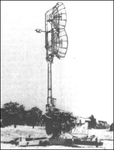Between Dunkirk and Brest there were sixty-six radar stations. To attack them all, even with the formidable air strength available to the Allies, was hardly possible and it was therefore decided to combine assault by air with radio counter-measures.
My take on it is that they didn't attack the radar stations until just before D Day because they could be replaced too easily. According to Wiki, the Germans produced more than 1,000 Freya sets and more than 4,000 Würzburgs.

